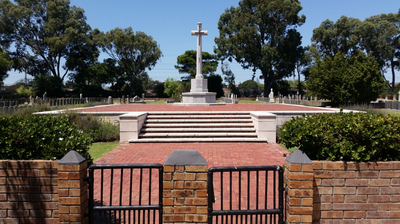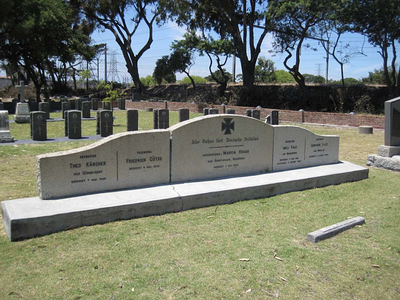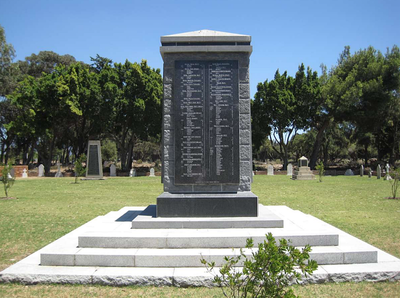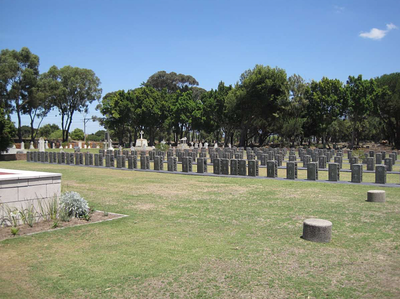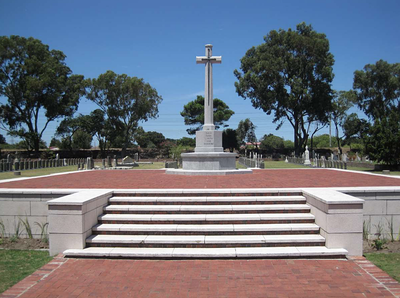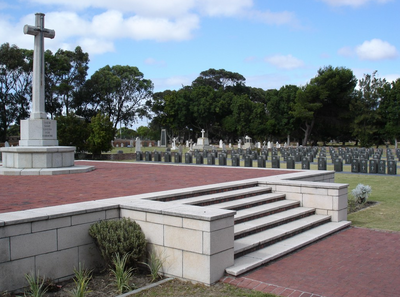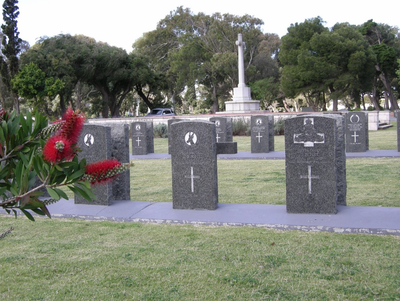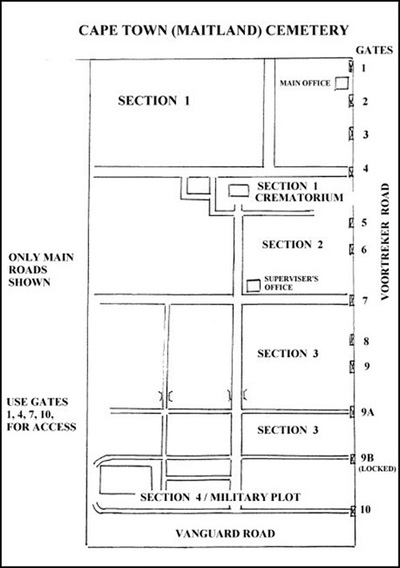CAPE TOWN (MAITLAND) CEMETERY AND CREMATION MEMORIAL
Western Cape
South Africa
Location Information
Cape Town (Maitland) Cemetery is situated 11 kilometres from the centre of Cape Town beyond Maitland.
Take the N1 in the direction of Paarl, then the N7 off-ramp in the direction of Goodwood up to the intersection with Voortrekker Road. Turn right and the cemetery, which is 3.5 kilometres long, is on the left.
To get to the cemetery follow the N1 national road to the N7 Malmesbury/Goodwood West off ramp, then take the Goodwood West road (Vanguard Road) and turn right at the intersection with Voortrekker Road (the first major intersection) and immediately left into gate No. 10.
Visiting Information
The cemetery consists of four sections. The 1914-1918 Commonwealth war graves are mainly in Section 4 and the 1939-1945 Commonwealth war graves are mainly in the Military Plot at the rear of Section 4, which has a large raised platform and a Cross of Sacrifice feature. Around 200 other Commonwealth war graves are scattered throughout the Sections. It may be necessary to consult the Secretary, C.W.G.C. South African Agency, or the Cemetery Authorities about the position of the graves.
Historical Information
Cape Town and the nearby Simon's Town were the scene of massive shipping movements (including hospital ships) during both World Wars. Many of the Commonwealth war graves of the First World War are associated with No.2 South African General Hospital at Maitland. During the Second World War naval and maritime air operations were conducted from the area. Instruction under the Empire Air Training scheme was conducted at 65 and 66 Air School at Youngsfield Aerodrome in the Wynberg area, and the Fleet Air Arm was established across the road from the cemetery at the Wingfield Aerodrome.
Cape Town (Maitland) Cemetery contains 437 Commonwealth burials of the First World War and 528 from the Second World War. There are also nine war graves of other nationalities within the cemetery and over 540 non-war burials (mostly Anglo Boer war graves) in the Commission's care here.
Within the cemetery stands the Cape Town (Maitland) Cremation Memorial which commemorates by name 17 casualties of the Second World War.
Cemetery pictures used with the permission of the Commonwealth War Graves Commission
Cape Town (Maitland) Cemetery is situated 11 kilometres from the centre of Cape Town beyond Maitland.
Take the N1 in the direction of Paarl, then the N7 off-ramp in the direction of Goodwood up to the intersection with Voortrekker Road. Turn right and the cemetery, which is 3.5 kilometres long, is on the left.
To get to the cemetery follow the N1 national road to the N7 Malmesbury/Goodwood West off ramp, then take the Goodwood West road (Vanguard Road) and turn right at the intersection with Voortrekker Road (the first major intersection) and immediately left into gate No. 10.
Visiting Information
The cemetery consists of four sections. The 1914-1918 Commonwealth war graves are mainly in Section 4 and the 1939-1945 Commonwealth war graves are mainly in the Military Plot at the rear of Section 4, which has a large raised platform and a Cross of Sacrifice feature. Around 200 other Commonwealth war graves are scattered throughout the Sections. It may be necessary to consult the Secretary, C.W.G.C. South African Agency, or the Cemetery Authorities about the position of the graves.
Historical Information
Cape Town and the nearby Simon's Town were the scene of massive shipping movements (including hospital ships) during both World Wars. Many of the Commonwealth war graves of the First World War are associated with No.2 South African General Hospital at Maitland. During the Second World War naval and maritime air operations were conducted from the area. Instruction under the Empire Air Training scheme was conducted at 65 and 66 Air School at Youngsfield Aerodrome in the Wynberg area, and the Fleet Air Arm was established across the road from the cemetery at the Wingfield Aerodrome.
Cape Town (Maitland) Cemetery contains 437 Commonwealth burials of the First World War and 528 from the Second World War. There are also nine war graves of other nationalities within the cemetery and over 540 non-war burials (mostly Anglo Boer war graves) in the Commission's care here.
Within the cemetery stands the Cape Town (Maitland) Cremation Memorial which commemorates by name 17 casualties of the Second World War.
Cemetery pictures used with the permission of the Commonwealth War Graves Commission

T/550 Conductor Horace Henry Glasock, V. C. (Received the V. C. during the Boer War)
Transports and Remounts, South African Service Corps, died 20th October 1916, aged 36. Plot Sec 4, 97317A.
Son of Henry Glasock; husband of M. L. Glasock, of 149, Sheffield St., Kenilworth, Johannesburg. Born in London, England.
Citation: An extract taken from the London Gazette records the following: "War Office, June 26, 1900. The Queen has been graciously pleased to confirm the grant of the decoration of the Victoria Cross to the undermentioned officer, non-commissioned officer and soldiers, which decoration has been provisionally conferred upon them by Field-Marshal Commanding-in-Chief in South Africa, in accordance with the rules laid down in Her Majesty's Warrant instituting the decwas most severe and the distance considerable. In consequence all concerned were so exhausted that they were unable to drag in the remaining limbers or the fifth gun. It now became necessary to risk the horses, and volunteers were called for from among the drivers, who readily responded. Several horses were killed and men wounded, but at length only one gun and one limber were left exposed. Four separate attempts were made to rescue these, but when no more horses were available the attempt had to be given up and the gun and limber were abandoned. Meanwhile the other guns had been sent on, one at a time, and after passing within 700 or 800 yards of the enemy, in rounding the head of a donga and crossing two spruits they eventually reached a place of safety, where the battery was re-formed. After full consideration of the circumstances of the case the Field-Marshal Commanding-in-Chief in South Africa formed the opinion that the conduct of all ranks of Q Battery, Royal Horse Artillery, was conspicuously gallant and daring, but that all were equally brave and devoted in their behaviour. He therefore decided to treat the case of the battery as one of collective gallantry under Rule 13 of the Victoria Cross Warrant, and directed that one Officer should be selected for the decoration of the Victoria Cross by the Officers, one non-commissioned officer by the non-commissioned officers, and two gunners or drivers by the gunners and drivers. A difficulty arose with regard to the Officer, owing to the fact that there were only two unwounded Officers - Major Phipps-Hornby and Captain Humphreys - available for the work of saving the guns and both of these had been conspicuous by their gallantry and by the fearless manner in which they exposed themselves, and each of them nominated the other for the decoration. It was ultimately decided in favour of Major Phipps-Horby as having been the senior concerned." Driver H. H. Glasock was elected by the gunners and drivers, as described above.oration, for their conspicuous bravery during the action at Korn Spruit on the 31st March, 1900. "On the occasion of the action at Korn Spruit on the 31st March, 1900. a British force, including two batteries of the Royal Horse Artillery, was retiring from Thabanchu towards Bloemfontein. The enemy had formed an ambush at Korn Spruit, and before their presence was discovered by the main body had captured the greater portion of the baggage column and five out of the six guns of the leading battery. When the alarm was given Q Battery, Royal Horse Artillery, was within 300 yards of the Spruit. Major Phipps-Hornby, who commanded it, at once wheeled about and moved off at a gallop under a very heavy fire. One gun upset when a wheel horse was shot, and had to be abandoned, together with a waggon, the horses of which were killed. The remainder of the battery reached a position close to some unfinished railway buildings and came into action 1,150 yards from the Spruit, remaining in action until ordered to retire. When the order to retire was received Major Phipps-Hornby ordered the guns and their limbers to be run back by hand to where the teams of uninjured horses stood behind the unfinished buildings. The few remaining gunners, assisted by a number of Officers and men of a party of Mounted Infantry, and directed by Major Phipps-Hornby and Captain Humphreys, the only remaining Officers of the battery, succeeded in running back four of the guns under shelter. One or two of the limbers were similarly withdrawn by hand, but the work was most severe and the distance considerable. In consequence all concerned were so exhausted that they were unable to drag in the remaining limbers or the fifth gun. It now became necessary to risk the horses, and volunteers were called for from among the drivers, who readily responded. Several horses were killed and men wounded, but at length only one gun and one limber were left exposed. Four separate attempts were made to rescue these, but when no more horses were available the attempt had to be given up and the gun and limber were abandoned. Meanwhile the other guns had been sent on, one at a time, and after passing within 700 or 800 yards of the enemy, in rounding the head of a donga and crossing two spruits they eventually reached a place of safety, where the battery was re-formed. After full consideration of the circumstances of the case the Field-Marshal Commanding-in-Chief in South Africa formed the opinion that the conduct of all ranks of Q Battery, Royal Horse Artillery, was conspicuously gallant and daring, but that all were equally brave and devoted in their behaviour. He therefore decided to treat the case of the battery as one of collective gallantry under Rule 13 of the Victoria Cross Warrant, and directed that one Officer should be selected for the decoration of the Victoria Cross by the Officers, one non-commissioned officer by the non-commissioned officers, and two gunners or drivers by the gunners and drivers. A difficulty arose with regard to the Officer, owing to the fact that there were only two unwounded Officers - Major Phipps-Hornby and Captain Humphreys - available for the work of saving the guns and both of these had been conspicuous by their gallantry and by the fearless manner in which they exposed themselves, and each of them nominated the other for the decoration. It was ultimately decided in favour of Major Phipps-Horby as having been the senior concerned." Driver H. H. Glasock was elected by the gunners and drivers, as described above.
Transports and Remounts, South African Service Corps, died 20th October 1916, aged 36. Plot Sec 4, 97317A.
Son of Henry Glasock; husband of M. L. Glasock, of 149, Sheffield St., Kenilworth, Johannesburg. Born in London, England.
Citation: An extract taken from the London Gazette records the following: "War Office, June 26, 1900. The Queen has been graciously pleased to confirm the grant of the decoration of the Victoria Cross to the undermentioned officer, non-commissioned officer and soldiers, which decoration has been provisionally conferred upon them by Field-Marshal Commanding-in-Chief in South Africa, in accordance with the rules laid down in Her Majesty's Warrant instituting the decwas most severe and the distance considerable. In consequence all concerned were so exhausted that they were unable to drag in the remaining limbers or the fifth gun. It now became necessary to risk the horses, and volunteers were called for from among the drivers, who readily responded. Several horses were killed and men wounded, but at length only one gun and one limber were left exposed. Four separate attempts were made to rescue these, but when no more horses were available the attempt had to be given up and the gun and limber were abandoned. Meanwhile the other guns had been sent on, one at a time, and after passing within 700 or 800 yards of the enemy, in rounding the head of a donga and crossing two spruits they eventually reached a place of safety, where the battery was re-formed. After full consideration of the circumstances of the case the Field-Marshal Commanding-in-Chief in South Africa formed the opinion that the conduct of all ranks of Q Battery, Royal Horse Artillery, was conspicuously gallant and daring, but that all were equally brave and devoted in their behaviour. He therefore decided to treat the case of the battery as one of collective gallantry under Rule 13 of the Victoria Cross Warrant, and directed that one Officer should be selected for the decoration of the Victoria Cross by the Officers, one non-commissioned officer by the non-commissioned officers, and two gunners or drivers by the gunners and drivers. A difficulty arose with regard to the Officer, owing to the fact that there were only two unwounded Officers - Major Phipps-Hornby and Captain Humphreys - available for the work of saving the guns and both of these had been conspicuous by their gallantry and by the fearless manner in which they exposed themselves, and each of them nominated the other for the decoration. It was ultimately decided in favour of Major Phipps-Horby as having been the senior concerned." Driver H. H. Glasock was elected by the gunners and drivers, as described above.oration, for their conspicuous bravery during the action at Korn Spruit on the 31st March, 1900. "On the occasion of the action at Korn Spruit on the 31st March, 1900. a British force, including two batteries of the Royal Horse Artillery, was retiring from Thabanchu towards Bloemfontein. The enemy had formed an ambush at Korn Spruit, and before their presence was discovered by the main body had captured the greater portion of the baggage column and five out of the six guns of the leading battery. When the alarm was given Q Battery, Royal Horse Artillery, was within 300 yards of the Spruit. Major Phipps-Hornby, who commanded it, at once wheeled about and moved off at a gallop under a very heavy fire. One gun upset when a wheel horse was shot, and had to be abandoned, together with a waggon, the horses of which were killed. The remainder of the battery reached a position close to some unfinished railway buildings and came into action 1,150 yards from the Spruit, remaining in action until ordered to retire. When the order to retire was received Major Phipps-Hornby ordered the guns and their limbers to be run back by hand to where the teams of uninjured horses stood behind the unfinished buildings. The few remaining gunners, assisted by a number of Officers and men of a party of Mounted Infantry, and directed by Major Phipps-Hornby and Captain Humphreys, the only remaining Officers of the battery, succeeded in running back four of the guns under shelter. One or two of the limbers were similarly withdrawn by hand, but the work was most severe and the distance considerable. In consequence all concerned were so exhausted that they were unable to drag in the remaining limbers or the fifth gun. It now became necessary to risk the horses, and volunteers were called for from among the drivers, who readily responded. Several horses were killed and men wounded, but at length only one gun and one limber were left exposed. Four separate attempts were made to rescue these, but when no more horses were available the attempt had to be given up and the gun and limber were abandoned. Meanwhile the other guns had been sent on, one at a time, and after passing within 700 or 800 yards of the enemy, in rounding the head of a donga and crossing two spruits they eventually reached a place of safety, where the battery was re-formed. After full consideration of the circumstances of the case the Field-Marshal Commanding-in-Chief in South Africa formed the opinion that the conduct of all ranks of Q Battery, Royal Horse Artillery, was conspicuously gallant and daring, but that all were equally brave and devoted in their behaviour. He therefore decided to treat the case of the battery as one of collective gallantry under Rule 13 of the Victoria Cross Warrant, and directed that one Officer should be selected for the decoration of the Victoria Cross by the Officers, one non-commissioned officer by the non-commissioned officers, and two gunners or drivers by the gunners and drivers. A difficulty arose with regard to the Officer, owing to the fact that there were only two unwounded Officers - Major Phipps-Hornby and Captain Humphreys - available for the work of saving the guns and both of these had been conspicuous by their gallantry and by the fearless manner in which they exposed themselves, and each of them nominated the other for the decoration. It was ultimately decided in favour of Major Phipps-Horby as having been the senior concerned." Driver H. H. Glasock was elected by the gunners and drivers, as described above.

